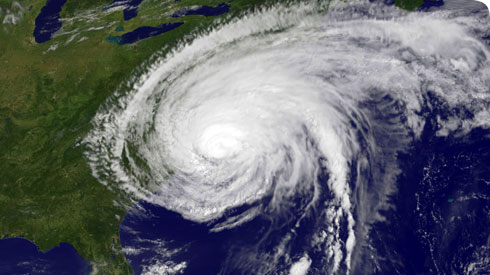Hurricanes
Hurricanes are often reported in the news but what causes them and how much warning is it possible to give the people living in affected areas?
What is a hurricane?
Also known as a typhoon or tropical cyclone, a hurricane is a storm system. It has a central ‘eye’ of low atmospheric pressure and circulating winds of over 74 mph. In the northern hemisphere, the wind in a hurricane moves in an anti-clockwise direction, although the air at the top moves clockwise. These directions are reversed in the southern hemisphere.
Energy is released when the air rises and cools so that water vapour turns into liquid water droplets. This process generates heat which in turn makes more air rise, and so on in a vicious circle. The result is torrential rain, strong winds, and often storm surge, unusually high sea levels that can be particularly devastating during high tides.
So is storm surge the same as a tsunami?
No. Tsunamis are the result of earthquakes or volcanoes underneath the sea bed. They are caused by geological processes. Storm surges are caused by meteorological factors, or weather systems. They take place when the low pressure at the centre of the hurricane sucks the sea surface upwards.
How frequent are hurricanes?
NASA has estimated that about 85 hurricanes occur in the world each year. Some begin or end as ordinary storms and may only exist as a hurricane for a matter of hours, while others may rage for several weeks.
Do they only occur in the tropics?
Hurricanes are almost always formed in tropical regions but they can then move into non-tropical waters. The tropics lie between the Tropic of Cancer and the Tropic of Capricorn, or 23.4° north and south of the equator. Hurricanes don't normally form in the tropical regions closest to the equator as they rely on the clockwise and anti-clockwise movements of air deeper into the two hemispheres to make them spin.
How are hurricanes monitored?
Meteorologists can usually predict the approach of a tropical storm but they might not be able to predict how strong it will be. The strength can increase quickly without any warning.
However, recent technology has allowed scientists to transform data into a 3D image of the storm’s intensity that gets updated every few minutes as it approaches land. Aeroplanes can also fly into hurricanes to take scientific readings.
Satellite images are very important for monitoring hurricanes and so are observations from airports, ships, and weather observation stations.
Do they occur over land as well as sea?
No. Tropical cyclones are formed over the sea and lose power once they move over land. This is why coastal areas are always worst affected. The surface temperature of the sea needs to be more than 26.5 degrees for a hurricane to develop.
How are hurricanes named?
Naming is carried out by the World Meteorological Association (WMO) using lists prepared several years in advance. There are different lists for different regions.
When Europeans first arrived in the West Indies, hurricanes there were named after the Saint’s Day on which they took place. It wasn’t until the late 19th century that meteorologist Clement Lindley Wragge began the practice of naming hurricanes after people. Female names were always used until concerns were raised that this might be rather sexist, as hurricanes are very destructive systems. The WMO started introducing masculine names in 1979.
Hurricane names are not re-used if they belonged to a particularly destructive storm. For example, there will never be another hurricane named Katrina or Andrew.
Why do hurricanes have names?
This is to enable people to distinguish between different hurricanes when there is more than one in an area at once. Names are also easier to remember and communicate than a number or grid reference. Usually a hurricane keeps the same name throughout its ‘life’.
Toolbox

In World War II the Museum was used as a secret base to develop new gadgets for allied spies, including an exploding rat!
